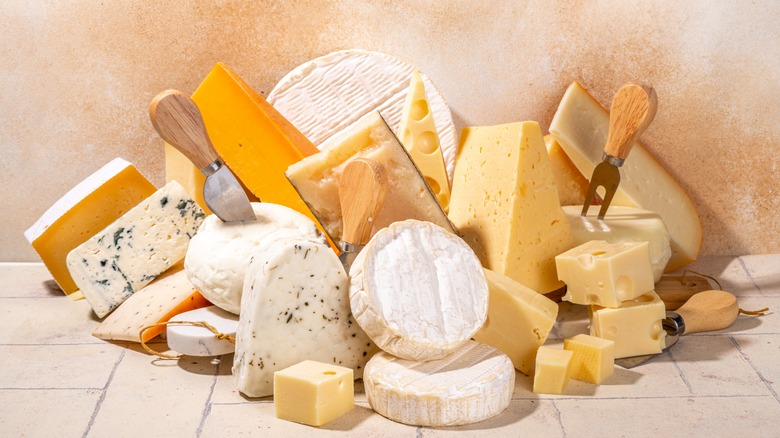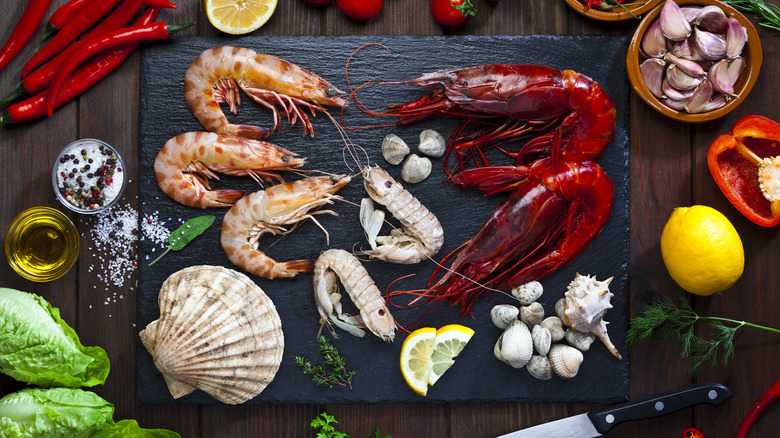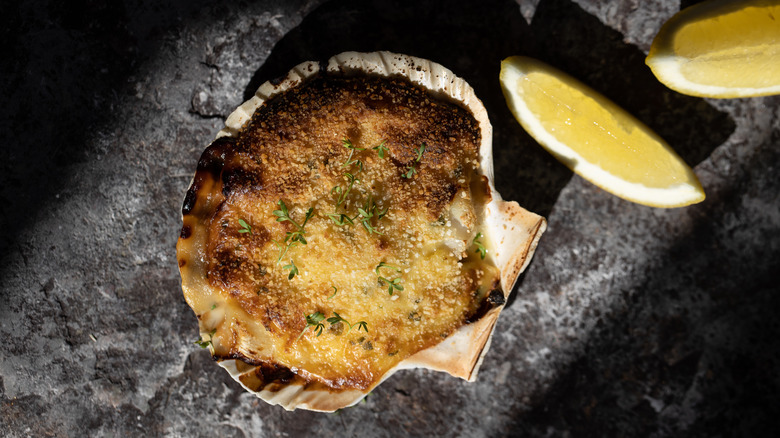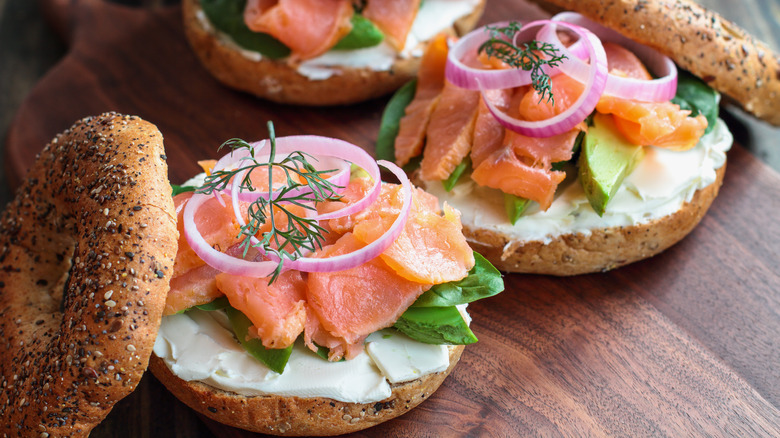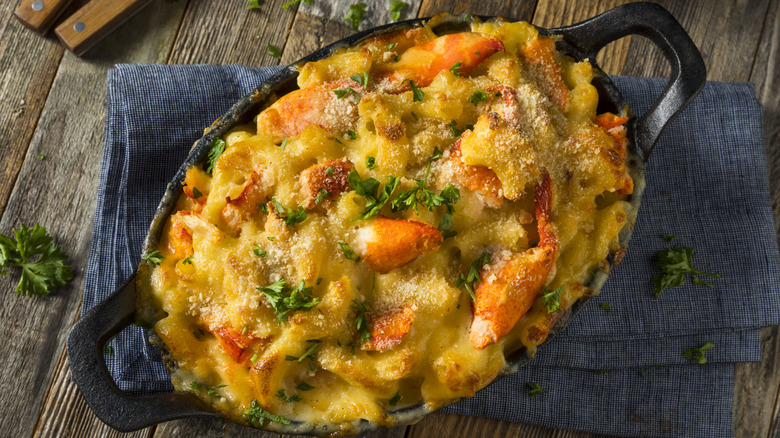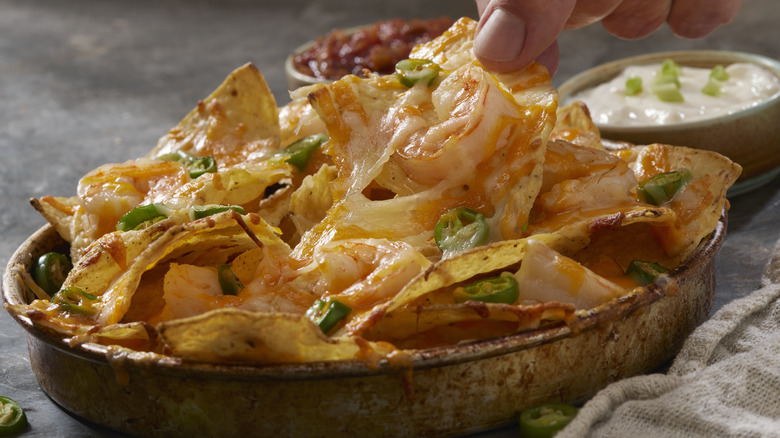Seafood And Cheese Are Meant To Be Together, Here's Why
I have always enjoyed combining dairy and seafood. From seared fish filets served with a cream sauce to lobster halves broiled under a blanket of cheese, there's something special about the combination of sweet and mild seafood and the creaminess and smoothness of dairy. Plus, as a cheese lover, I believe it makes everything better.
So when it comes to combining seafood and cheese, it always surprises me that many of my friends, even many self-described gourmands, are adamantly against it. According to them, the delicate flavor of fish simply clashes with the strong taste of cheese, creating a muddled flavor that tastes like neither. But that is simply not true. While I am not advocating melting Kraft singles on pieces of Chilean sea bass, pairing the right cheese with the right seafood will create a magical taste and textural sensation that will banish this supposed culinary taboo for good.
Cheese and seafood: a love story
The practice of consuming seafood and dairy probably goes back millennia. For example, ancient Romans consumed both cheese and a fish sauce named garum, and it is likely that the two ingredients have crossed paths at some point. According to the dietary laws of the Jewish faith, which stretches back to the 6th century, pairing milk products and fish is acceptable. On the other hand, it is prohibited to consume meat and dairy together at the same meal. This is why there are no cheeseburgers in a kosher deli, but you can find smoked salmon served with cream cheese.
So where did this culinary taboo of mixing fish and cheese come from? According to historians, the ban on mixing cheese and fish might have been for medical reasons. During the early development of medical science, when there was less of an understanding of how the body works, consuming fish and cheese was supposed to be detrimental to one's health. As time went on, the reason for the prohibition was forgotten, but the prohibition remained, especially in some countries such as Italy. However, countries like France have long paired dairy with seafood, such as mussels in a Roquefort sauce.
Right choices makes all the difference
So are the detractors correct? Should we keep cheese far away from seafood? I don't think so. While the flavor of some cheeses might clash with some seafood, it is simply the matter of choosing the right cheese to pair with the right seafood. Similar to matching the right fruit to go with chocolate, the immense diversity of both cheese and seafood means there are many ways to make both sing in harmony in a recipe.
For example, let's start with hard cheeses such as parmesan, pecorino, and Grana Padano. Although I do not like to shower parmesan cheese on a plate of linguine alla vongole (white clam sauce) because I find its flavor overwhelming, it is the perfect match as a crumb topping for cod or other firm white fish. When mixed with breadcrumbs and herbs, grated parmesan serves as a salty and umami-packed accent that works perfectly with thick and mild fishes such as halibut and cod.
Or let's consider a semi-soft cheese such as Gruyere. Most often seen melted atop French onion soup, it is also a fantastic companion for seafood as a topping or as part of a sauce. Consider coquille St. Jacques, an old-school French cuisine classic consisting of fresh scallops baked in scallop shells in a creamy and cheesy sauce, which contains grated Gruyere cheese. Or ponder the fact that Swiss cheese and tuna salad go together like a horse and carriage in a tuna melt.
Endless cheese possibilities
But wait, there's more. How about cream cheese? This American classic has been paired with fish and seafood in a variety of ways. It has been folded with crab meat to create a baked dip alongside parmesan cheese as a topping, its creamy body providing the salty binding for shards of sweet crab meat. It makes for a perfect partner with salmon, appearing alongside the pink fish in sushi rolls and smeared on a bagel under pieces of luscious smoked salmon.
On the salty side, feta's brininess makes for a perfect foil to the delicate sweetness of fish, serving as a topping for roasted white fish with tomatoes and herbs. Meanwhile, mild, creamy mozzarella is not only perfect when melted on top of a jumbo shrimp parmesan, but its soft texture is also fantastic when chopped up with diced tomato and tossed with citrus-marinated seafood for a main course salad.
Even blue cheese, arguably the strongest tasting among all common cheeses, has a place in seafood cooking. If you are skeptical, I invite you to try pairing a jumbo shrimp cocktail with blue cheese dipping sauce and experience the combination of sweet, succulent, and crunchy shrimp with the salty funky punch of blue cheese.
Seafood mac and cheese, the ultimate cheese and seafood collaboration
Until now, all the talk about pairing cheese with seafood has been focused on using cheese to enhance seafood, not the other way around. However, I am simply saving the best for last, because in my opinion, the singular best collaboration of cheese and seafood is mac and cheese. There is nothing quite like the combination of velvety bechamel sauce, al dente pasta, a mix of cheeses, briny seafood, and crunchy topping that provides a feast of contrasting yet complementary taste and texture. Whether you are using chunks of silky salmon, small and sweet bay scallops, briny prawns, or luxurious lobster, there is no denying that mac and cheese and seafood are a match in heaven. The dish is also extremely versatile, able to serve as a main course alongside a salad one night and as a side dish with grilled steaks the next.
When it comes to choosing the right cheese for a seafood mac and cheese, I recommend good quality melting cheese such as Gruyere for the mac and cheese itself and a mix of pecorino and parmesan for the breadcrumb and herb topping. Cook the seafood separately until 80% done before folding it into the mac and cheese, as it will cook all the way through when you finish it in the oven and broiler.
Seafood and cheese belong together, period
As a culinary pairing, seafood and cheese is one of those combinations that might sound strange at first glance but makes perfect sense when you consider the many times you might have enjoyed it without even thinking about it. Whether as an enhancement or as the main ingredient, cheese and seafood complement each other both in terms of taste and texture. So, whether you're savoring a creamy lobster mac and cheese or relishing the briny sweetness of scallops with a delicate cheese sauce, remember that in the world of food, there are no rigid rules, only endless possibilities waiting to be explored.

